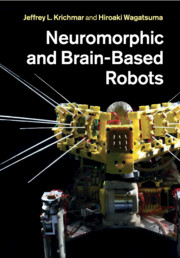Book contents
- Frontmatter
- Contents
- Contributors
- Preface
- Part I Introduction
- Part II Neuromorphic robots: biologically and neurally inspired designs
- 2 Robust haptic recognition by anthropomorphic robot hand
- 3 Biomimetic robots as scientific models: a view from the whisker tip
- 4 Sensor-rich robots driven by real-time brain circuit algorithms
- Part III Brain-based robots: architectures and approaches
- Part IV Philosophical and theoretical considerations
- Part V Ethical considerations
- Index
- References
3 - Biomimetic robots as scientific models: a view from the whisker tip
from Part II - Neuromorphic robots: biologically and neurally inspired designs
Published online by Cambridge University Press: 05 February 2012
- Frontmatter
- Contents
- Contributors
- Preface
- Part I Introduction
- Part II Neuromorphic robots: biologically and neurally inspired designs
- 2 Robust haptic recognition by anthropomorphic robot hand
- 3 Biomimetic robots as scientific models: a view from the whisker tip
- 4 Sensor-rich robots driven by real-time brain circuit algorithms
- Part III Brain-based robots: architectures and approaches
- Part IV Philosophical and theoretical considerations
- Part V Ethical considerations
- Index
- References
Summary
Introduction
Why build robot models of animals and their nervous systems? One answer is that in building a robot model of a target organism, which mimics sufficiently some aspects of that animal’s body, brain, and behavior, we can expect to learn a good deal about the original creature. Synthesis (engineering) is quite different from analysis (reverse-engineering), is often easier, and teaches fascinating lessons (Braitenberg, 1986). Another answer is that a robot model should allow us to conduct experiments that will help us better understand the biological system, and that would be impossible or at least much more difficult to perform in the original animal (Rosenblueth and Wiener, 1945). In this chapter our target organism is the rat and our specific focus is on the sophisticated tactile sensory system provided by that animal’s facial whiskers (vibrissae). Neurobiology shows us that the brain nuclei and circuits that process vibrissal touch signals, and that control the positioning and movement of the whiskers, form a neural architecture that is a good model of how the mammalian brain, in general, coordinates sensing with action. Thus, by building a robot whisker system we can take a significant step towards building the first robot “mammal.” Following a short review of relevant rat biology, this chapter will describe the design and development of two whiskered robot platforms – Whiskerbot and SCRATCHbot – that we have constructed in order to better understand the rat whisker system, and to test hypotheses about whisker control and vibrissal sensing in a physical brain-based device. We provide a description of each platform, including mechanical, electronic, and software components, discussing, in relation to each component, the design constraints we sought to meet and the trade-offs made between biomimetic ideals and engineering practicalities. Some results obtained using each platform are described together with a brief outline of future development plans. Finally, we discuss the use of biomimetic robots as scientific models and consider, using the example of whiskered robots, what contribution robotics can make to the brain and behavioral sciences.
- Type
- Chapter
- Information
- Neuromorphic and Brain-Based Robots , pp. 23 - 57Publisher: Cambridge University PressPrint publication year: 2011
References
- 13
- Cited by

